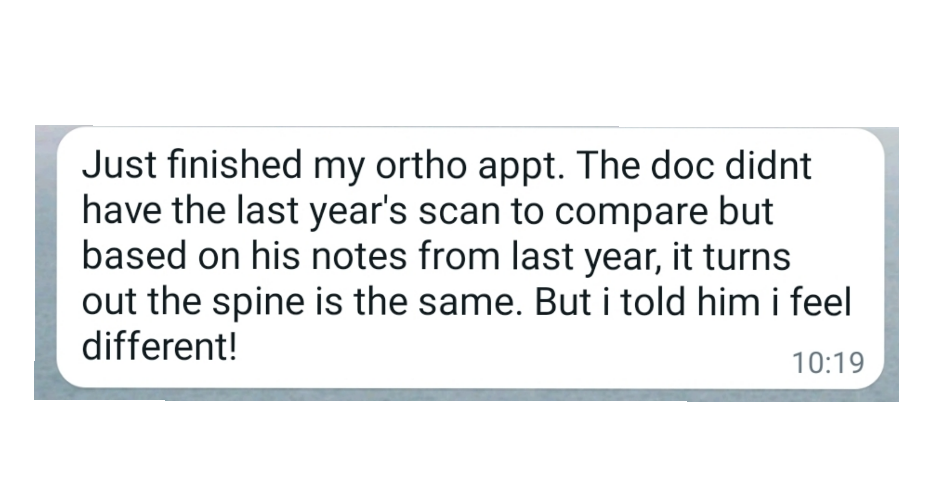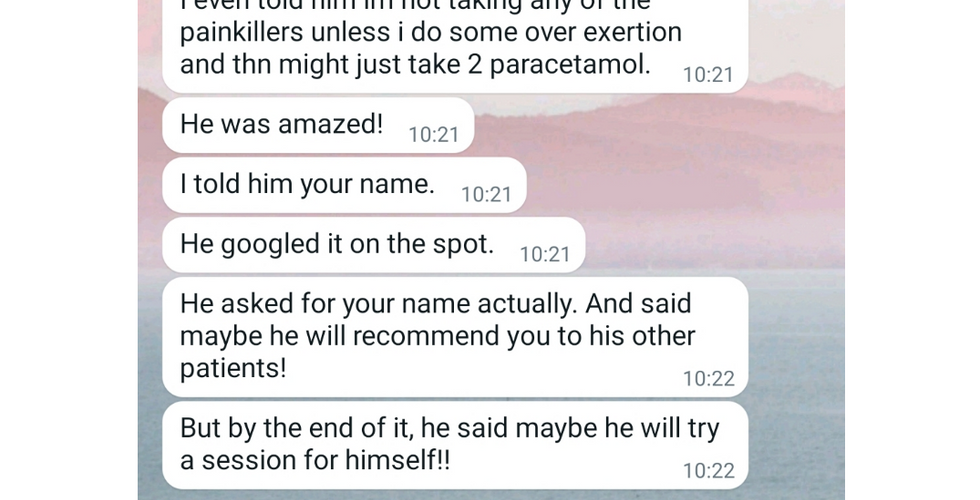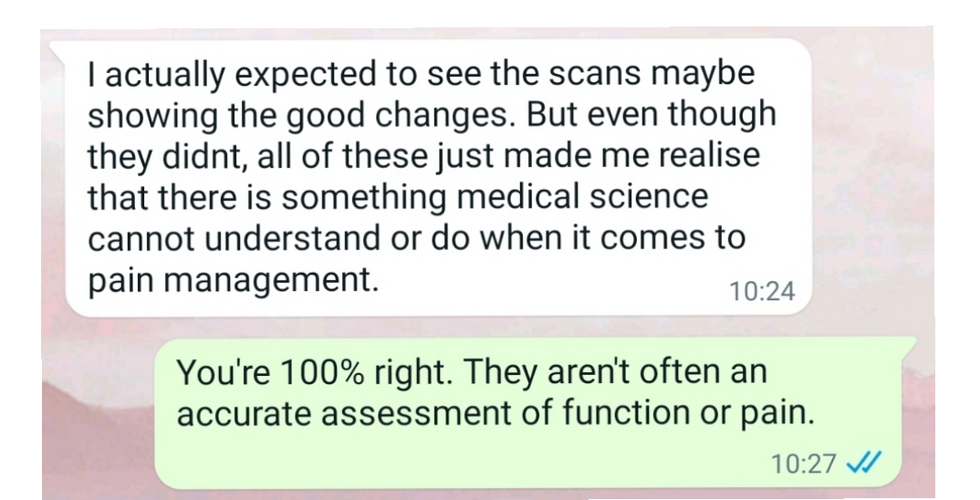"You Will Have To Live In Pain Forever"
- Sheela Cheong

- Apr 8, 2022
- 12 min read
Updated: Jun 24
JANUARY 2022
Wow. I just taught one of the most challenging classes in my life. I'm still a little shell-shocked. The student cried with me, shared her pain with me, and by some miracle, left class happy & relaxed despite the intense pain she was in. It was our first meeting - and her first yoga class.
When she came up to my door, I could see she was walking painfully. Not only was she was bent over, like the old women I'd see at the market; her pelvis was horribly tilted, with one hip higher than the other. I say this not to shame her but to paint a picture of how it looked like someone had literally bent her out of shape.
"I'm young, but hobbling like an old woman," she would say later.
E v e r y single Yoga asana I tried with her, hurt her.
What hurts? I asked.
She ranked them in order:
1. Standing (the worst)
2. Walking
3. Sitting
4. Lying down (She couldn't lie on her back and even fetal position was unbearable).
Together, we figured out that the least painful position was having her seated with her spine gently rounded. I had her sit on a firm cushion, cross-legged with her back against the wall. When I slid a block under each knee, her whole body seemed to sag with relief. I felt so happy that we found this for her.

In Sanskrit, this yoga asana is called Sukhasana. The name comes from the Sanskrit words सुख sukha, "pleasure", and आसन āsana, "posture" or "seat".
"I feel more comfortable when I slouch," she said after awhile, sounding almost embarrassed.
"Slouch," I replied. "Be comfortable."
We sat like this for the rest of class.
My parting words for her were: "Follow your pleasure. Pay attention to what feels good and do that."
I wrote the above the night after meeting Rani for the first time. Rani first contacted me for help with her back pain. These are the messages she sent and my response to taking her on as a student:
In our first class, once she was able to be sit and breathe comfortably, we were able to have a conversation about her pain. Since then, we have had class regularly. With her permission, I am sharing her story as was told to me.
RANI'S STORY
When did your physical pain start? Where in your body was it located?
I had a big fall from a cliff when I was in my teens, this could have been my first physical injury to the spine area. Later, I was in an abusive relationship - physical, mental, emotional, verbal, and sexual abuse. I was forced upon. During the struggle, my pelvic area was badly affected. In another episode, I was thrown against a sharp corner which hit my hip hard. I didn’t realise it at first but those around me began to notice that I wasn’t standing straight anymore. My hip was jutting out to one side. I was 18 years old.
What was your experience with doctors & hospitals?
I can’t recall when it started but I've had to check myself into A&E at least once a year. It was like an odd body clock - my body was able to function for about a year before it would break down. Even though I had been to the hospital multiple times for back pain, the doctors didn’t suggest I see a spine specialist until I requested it. I was then sent for an MRI.

The first specialist was blunt and heartless. He did not explain anything and only said: “You have slipped discs, which means you will have to live in pain forever”. I requested a change of specialist for my next appointment.
This time, the doctor explained what was wrong. He showed me my MRI, the dark areas where the discs were absent or barely there. He also explained that he wouldn’t recommend surgery because my spine was in an extremely fragile state and any surgery may cause further complications. He suggested physiotherapy but added: "To be honest, physiotherapy is for minor injuries - not something like this."
I went for one physiotherapy appointment. The doctor's lack of confidence didn't inspire me and I only felt more pain after the first session. I continued to suffer and popped countless painkillers to do normal things. Although I looked fine from the outside, I felt disabled.
In December 2020, I had the worst flare-up. At work, I had to pack boxes and do some heavy lifting, and it aggravated my already bad back. As usual, I was given a week off work and painkillers - except, this time, even with a week's rest, I was unable to stand or walk. Again, physiotherapy was advised, and surgery. But I refused.
The less invasive option was steroid jabs into the spine to relief nerve pressure. I was assured that in the worst-case scenario, it wouldn't have any effect on my condition. However, as with any medical procedure, I still had to sign off that the doctors and hospital were not liable if things went side-ways - and in my case they did.
The jab was scheduled for February 2021.
During the procedure, the doctor hit very close to a nerve and I felt an excruciating shot of pain.
As it was a day surgery, I was told that patients would be discharged 10 minutes after the procedure. I, however, could not feel my legs for 2 hours.
This procedure radically worsened the intensity of my pain. Previously, I had good days where I had mild or a more manageable level of pain. I could walk a fair distance and sit for long hours. After this procedure, I couldn’t walk! I couldn’t walk for more than 5 minutes at a time. I had constant pain shooting down my legs. After several months, I had numbness and tingling in my legs. It was the most I've suffered and felt like an eternity. I didn’t remember what life was like without pain. I couldn’t sleep, sit comfortably, or walk, which was the hardest on me.
What was your rock bottom?
In September 2021, all my inner demons that I'd been battling surfaced when my mum had a minor stroke. I was in constant fear even after my mum recovered. I couldn’t function on autopilot anymore. I was lost and drained. Yet, I was told by people around me that I needed to be strong and not add stress to anyone. I had no one I could freely engage with, I couldn’t relax at all and all of these further deteriorated my condition to the point that I could not walk at all and was bent for months. I became extremely suicidal. I was placed on medium to high risk for suicide by my psychologist.
In December 2021, other personal relationships were falling apart and I had my trust broken by several of my loved ones. At my latest visit to the A&E, I was at the lowest I had ever been - mentally, emotionally and PHYSICALLY so bent that I couldn't even stand up straight for my height to be taken. Although I am 175cm, I remember the electronic scale at Singapore General Hospital reading 165cm. It was the most suicidal period of my life. My spine was in such an aggravated state. By the time I came to Sheela for my first Yoga session, I was virtually bent double.
What made you want to try yoga?
I met a stranger, who noticed my back and asked about it. He mentioned he had a wheelchair-bound friend who attended Yoga class and now goes for jogs every morning. My mind was blown. I read articles about Yoga and everything it did for people. I told myself that Yoga will be what heals me, inside and out.
What made you contact me?
At the beginning of 2021 when I realised the damage that the steroid injections had done, I began to look for a Yoga teacher. I knew I had to opt for a teacher who understands trauma and injury. I also knew that given my condition, group classes weren't suitable for me. That was when I found Sheela's website. I realised that she had had an injury too and used her Yoga practice to get well again! I couldn’t believe how perfect it was that there was a Yoga teacher who'd understand my pain and not react like the doctors who previously attended to me. This is the single greatest choice I have made.
Why did you trust me?
Sheela isn’t a regular Yoga teacher. She has gone through similar experiences as me. A person might not be able to relate to pain if they have never experienced it, and that’s okay. But for my healing journey, I needed someone who understands what I am coming with. Sheela is mindful about how my day is before every session and gives me the space to share whatever I want. I was completely hopeless and Sheela gave me hope again.
How are our Yoga classes different from everything you've done before?
Doctors have constantly told me to lose weight so that my spine will improve. At the height of my pain, when I was visibly bent double, they told me the same. How to lose weight when I can barely walk!?
I also had a doctor who asked me to rate my pain on a scale of 1 to 10. When I answered 8, he replied mockingly: “8 is like breaking an ankle, are you sure you are at an 8?”
Isn’t pain subjective? Just because I wasn’t externally screaming in pain, doesn’t mean I was in any less pain.
The biggest difference is that there aren’t any expectations of me, except to be present in the practice and to say what is comfortable for me and my body.
I wasn’t told I couldn’t get better if I didn’t lose weight or change my diet. I wasn’t mocked for how I looked. I wasn’t made to question what I was feeling. I was just accepted, fully. From the moment we met, she never had a look of worry or doubt. This may seem simple, but it was very powerful for me: to see that she remained calm and confident. It made me feel reassured.
She focused on making me feel safe, loved and making me realise that I wasn’t a lost cause by creating an accepting, judgment-free space. I could wear anything, be however physically, whatever size, whatever emotion / mood, and still be accepted just as I am.
At every step, she asks how I feel, what is working for me, what is comfortable for me, and to feel free to change or modify anything according to how I feel. Shifting the chair, a little further, moving the cushions, bending my knees so I feel less pain. She made me listen to my body. Many of us rarely do this. She teaches us to connect with ourselves and if you are aware enough, you can feel that she is sending her loving, healing energy to you during the sessions. This level of commitment is extremely hard to find. And did I mention that there was never A SINGLE moment that I felt too big or needed to lose weight?
What were the main things that shifted you out of your pain?
I came to her completely broken. I genuinely couldn’t see a better day and I really wanted to end everything. She welcomed me with kindness and somehow found a simple way to let me breathe. Before this, I literally couldn’t even sleep or breathe without wincing. Sheela lifted the dread from my heart.
What did class actually look like?
First class: LISTEN TO MY BODY In my first class, I couldn’t do anything. I couldn't stand, sit, lie down. Nothing. Sheela suggested so many positions, but my body hurt and I couldn't breathe. Then, she had me sit cross-legged against a wall (to support my spine), with a yoga block under each knee. For the first time in MONTHS, the pain eased and I was able to breathe smoothly. I wish I'd documented this first class so people could see the condition I came to Sheela in. Within 3 classes, I was standing completely straight and WALKING with 85% less pain I had been having for over a decade.

Second class: BREATH
In my second class, Sheela taught me how to breathe. Breathing fully into the belly, releasing the shoulders down, taking note of even my eyebrows and facial muscles because I didn't know how to relax and take natural deep breaths. I had been in a constant state of physical pain for more than 10 years but in emotional / mental torture for even longer than that. Keeping everything stiff was the only way my body knew how to be. Nothing felt safe until I found Sheela.
Third class: ANGER
Anyone who knew me, knew my anger. I regarded my anger as a weapon and people around me were terrified of my temper. In the past, I had tried my best to subdue this part of me, but I was merely pushing everything down and barely keeping the lid on. Crucially, I also knew that this was worsening my back pain. For as long as I could remember, I had held so many emotions and trauma in my spine.
Sheela taught me that my anger was protection. She connected the anger I was holding in my body to the harrowing experiences I had gone through. This was my body's way of processing past events in present time.
My anger was a fierce protection that I held like a knife in hand to protect me from people and pain. This understanding awakened something very deeply in me, it felt like a jolt of transformation. #thebodykeepsthescore
If my life was a movie, this would be the climatic scene. Anger was the biggest part of my identity but Sheela changed my perception of anger from weapon to guardian. I strongly believe that no other yoga class could have uprooted this core belief of mine.

At this point, I began to wonder why I didn't get it when the physiotherapist and doctors told me to breathe and relax. I understood the verbal instruction but it didn't "click" until Sheela stepped in. She embodied such kind, healing energy that I opened up with her far more than I had with my psychologist.
Never have I been in such a completely non-judgmental environment. I wasn’t self-conscious, I wasn’t worried about how my body looked or what the other person might be thinking about me because Sheela actually didn’t care about that.
My Yoga classes are a joy in my healing journey. Each class ends with me feeling grounded, whole, happy and at peace. I try not to beat up myself for the fact that I didn’t come to Sheela sooner. I continuously sing praises about her to anyone whom I know will benefit from attending her classes. Her rates are very reasonable considering the level of personalisation you get. No matter what you may be going through - physical pain, mental torment, emotional instability - Sheela Cheong’s yoga will change that. I hope my experience will be able to help and guide anyone who is hesitant.
TEACHING THROUGH PAIN & TRAUMA
WHAT THEY DON'T TEACH YOU IN YOGA TEACHER TRAINING
Do traumatic life experiences cause back pain?
Does sitting cross-legged cure back pain?
The answer is that they both played a part - in Rani's life and experience.
Every person's pain is unique. The cause and cure for your pain will likely be different from hers.
Looking for a posture to fix a person is putting the carriage before the horse. This is the reason I'm not a fan of articles with titles like "5 Poses To Fix Your Back Pain". They grab our attention and give us hope but they may not work for every body.

'Sukhasana'
Image taken from 'Anatomy for Hip Openers And Forward Bends' by Ray Long MD, p. 27). (The arrows indicate the direction of energy / effort in the posture.)
Common cues for Sukhasana:
- Pelvis upright
- Lengthen the spine
- Neck in line with rest of the spine
- Abdomen lifted
- Chest lifted
- Collarbones broad
- Shoulders down from the ears
Something they don't teach in yoga teacher training is that often, what the teacher DOESN'T say can be more important than what they DO. With Rani, I didn't repeat any of the cues above.
When she sat in Sukhasana and confessed she felt more comfortable slouching, I replied: "Slouch. Be comfortable."
"You mean I don't have to sit up straight?"
"No, you don't. Let go of what you think you need to look like. Pay attention to what you are feeling in your body."
THE ANSWER IS IN THE PROBLEM
There are two different pedagogies:
I know all these postures that relieve back pain. I put them together in a sequence and teach that to the student in front of me.
I know all these postures that relieve back pain. But I don't know the student in front of me. I don't know her experience of her pain. Can I be curious with her? Can we let the pain be the starting point - and let that tell us what to do?
“To ask the 'right' question is far more important than to receive the answer. The solution of a problem lies in the understanding of the problem; the answer is not outside the problem, it is in the problem.” ― Jiddu Krishnamurti
The starting point in the first approach is: "I come to you with my knowledge."
The starting point in the second is: "I meet you where you are, with not-knowing and curiosity."
There is no magic pose.
The secret is to start with the pain.
For students, two questions you can start with right now are:
When did my pain start?
What was happening in my life at the time?
For teachers, how did I do this for Rani?
Undivided attention
Real, active listening
Believing vs questioning her story
In class with Rani, I knew it was a matter of figuring out what made her feel SAFE & COMFORTABLE which included:
The physical posture (for her)
My Voice
My tone / volume / pace
Choice of words
When to be silent
When to listen
When to guide / offer suggestions
When to share some of my own experiences
My Attention
My facial expressions
Eye contact
Body language(especially when she was crying / sharing personal trauma / having difficulty being in the postures)
At the end of our first class, Rani turned to me and said: "I thought after I couldn't do any of the poses, that you would give up on me!"
Me: "The thought never even entered my mind."
“The most precious gift we can offer anyone is our attention. When mindfulness embraces those we love, they will bloom like flowers.” ― Thich Nhat Hanh

Artwork by Aphra Natley, 'embracing the shadow', @asanctuaire on Instagram


























Comments